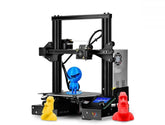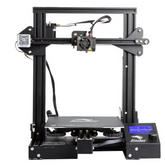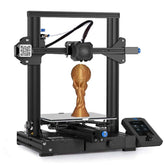All about 3D Printing
Summary
Discover the fascinating world of 3D printing in our comprehensive blog, "All about 3D Printing." Uncover the roots of this revolutionary technology with a brief history, delve into key 3D printing processes and unravel the magic of how they work. Explore current major applications shaping industries today and gain insights into forecasted areas of future growth. Finally, join us in envisioning the exciting developments ahead. Don't miss the chance to dive into the future of manufacturing and innovation. Your journey into the limitless possibilities of 3D printing starts here!
Introduction
Three-dimensional (3D) printing is formally known as additive manufacturing, the process of creating a physical object by depositing materials layer by layer based on a digital 3D model. In contrast with subtractive methods that remove material to achieve a desired form, additive 3D printing only places material where needed as defined by the computerized design. First invented in the early 1980s, contemporary 3D printers can rapidly print incredibly detailed and complex geometries directly from digital files out of plastic, resin, metal, and hundreds of other materials.
This transformative technology promises to completely reshape manufacturing as we know it over the next decade. With the design freedom, customization, streamlined workflows, and democratizing potential it provides, 3D printing is poised to drive the next industrial revolution. This article will provide an in-depth examination of how 3D printing works, current major application areas, projections on how it may transform industries in the future, and developments still needed to unlock its full potential.

Brief History of 3D Printing
The genesis of 3D printing can be traced back to 1976 when the inkjet printer was invented at IBM. This familiar home and office peripheral works by precisely spraying tiny ink droplets only where needed to build up text or images on paper. In the early 1980s, a group of innovative engineers at 3D Systems Inc expanded upon this concept with a new Rapid Prototyping (RP) approach they branded as Stereolithography (SLA). This groundbreaking system focused a ultraviolet laser beam to selectively cure and solidify an entire layer of liquid photopolymer resin based on computer input. After initially curing a cross sectional layer against a build platform, the SLA machine platform slightly lowered into the resin vat and repeated the process to stack additional layers together into full 3D objects.
In the decades since this pioneering SLA 3D printer, many new additive manufacturing processes have been developed. Each has relative strengths targeting different applications and materials. Now numbering over seven unique approaches commercially available, this article will explore the most impactful and promising 3D printing technologies seeing broad adoption today.
Key 3D Printing Processes and How They Work

Several distinct categories of 3D printing processes have gained prominence, with the four most widely used being:
Fused Deposition Modeling (FDM):
By far the most common and accessible 3D printing technology today builds objects out of spooled plastic filament, selectively depositing melted material layer by layer. Filament, usually ABS or PLA, is fed through a heated moving print head positioned over a flat build plate according to computer directed toolpaths matching sections of the 3D model. As the print head traces each new layer, melted plastic hardens shortly after extrusion bonding the entire printed part together. Although limited on finer details and surface finish, FDM 3D printers are extremely versatile and benefit from abundant low-cost filament materials.
Stereolithography (SLA):
Evolving from the original SLA 3D printing process developed in the 1980s, modern stereolithographic 3D printers still rely on photopolymer resins and ultraviolet light focused to an exact position by scanned laser or projected visible light source. As each new layer is selectively polymerized, the build platform lowers allowing the printed object to slowly emerge intact from the liquid resin bath. Uncured excess resin is then drained or rinsed away before final curing. Offering an excellent balance of detail resolution, strength, precision, and smooth surfaces, SLA continues growing rapidly in capability and popularity.
Selective Laser Sintering (SLS):
Rather than bonding liquid plastic particles as in SLA, SLS fuses small particles of plastic, ceramic, glass, and an expanding array of powdered materials using a high power CO2 laser to mimic welding or sintering. Guided by each new cross sectional layer imported into the machine, the laser scans and selectively fuses material in the temperature controlled powder bed before dispensing a fresh layer of powder overhead across the build area to start the next layer. SLS handles very complex geometries with enclosed voids easily and excels at functional prototypes and manufacturing plastic, composite, or metal parts.
Electron Beam Melting (EBM):
To fully unlock industrial scale metal 3D printing, Electron Beam Melting focuses thousands of watts of electron beam power enough to locally melt almost any metal alloy powder. Like SLS, parts build up additively layer-by-layer within a temperature controlled metallic powder bed environment needed to maintain dimensionality. As each fresh layer of powder is raked across the build area, the electron beam traces the toolpaths defining the current object cross section calculated from the 3D model. EBM produces fully dense high integrity metal parts for the most demanding applications.
Dozens of other niche 3D printing processes working with paper, food, concrete, wax, and new exotic materials continue pushing the capabilities of additive manufacturing into new frontiers. Underlying each is the unifying concept of constructing 3D objects upward layer-by-layer, depositing material only where needed by precisely following computer controlled toolpath instructions from sectioned 3D model data. This digital mediation enables almost unlimited freedom to produce designs far too complex to create by any previous means.
Current Major Application Areas

3D printing is currently seeing significant adoption across several key industries actively transforming design and manufacturing:
Industrial Manufacturing:
No area is being more impacted by the rise of 3D printing than fields like automobile, aerospace, medical devices, industrial machinery, and consumer products manufacturing. Streamlining concept design work by enabling rapid prototypes on demand directly from CAD software is proving tremendously valuable. Testing multiple prospective designs first as inexpensive 3D prints identifies issues early and minimizes costly tooling changes later. 3D printing also increasingly steps in for direct production manufacturing of niche, customized, or replacement parts built on demand without any specialized tooling required.
Healthcare and Medical Treatment:
Some of the most profound and emotionally impactful applications of 3D printing today are found improving and saving patients’ lives through custom matched implants, prosthetics, anatomical models, and drug delivery systems. Surgeons commonly utilize 3D printed models of patient hearts or other organs with defects in order to strategize and prepare for exceptionally complicated operations. Other trauma patients requiring cranial plates or long bone repairs following serious accidents can be fitted with 3D printed titanium implants shaped perfectly to replace their unique anatomy. In the future, 3D bioprinting may even print functioning biological tissues and organoids for revolutionary regenerative therapies.
Aerospace and Automotive:
Extremely strong yet lightweight parts are highly desirable across aerospace and automotive applications where saving weight directly correlates with better efficiency and performance. 3D printed lattices and mesh-like structures offer vastly improved strength-to-weight ratios over solid blocks of material when designed properly. Although initially developing these specialized lightweight 3D printable geometries proved challenging, validated design templates now exist allowing engineers to efficiently incorporate dense metallic lattices and advanced composites into aircraft and land vehicle designs manufactured by 3D printing.
Creative Industries:
For designers, sculptors, architects, and other creative professionals, 3D printing represents an entirely new design-to-manufacturing paradigm allowing physical designs not possible using any previous traditional means. Artists access a new kinetic medium enabling elaborate sculptural centerpieces with integrated moving elements to capture viewer attention. Fashion designers embrace stunning 3D printed accents and textures to incorporate into shoes, dresses, hats, and jewelry. Architects model intricately detailed building structures with nested internal voids or channels for utilities impossible to mold or cast. Creative artists are only beginning to explore this new world of opportunities.
Electronics:
Although still emerging in capability, 3D printing enables another class of intriguing applications when conductive materials are incorporated to directly print full electronic devices. Early integrated circuits, antennas, capacitive sensors, and electrical contacts fabricated by multi-material jetting combine electronic and mechanical functions into single 3D printed parts. As material options and precision continue improving, 3D printing promises to transform electronics by consolidating components and embedding advanced functionality like sensing or internet connectivity directly into 3D objects during fabrication.
Forecasting the Future and Developments Ahead

Industry analysts broadly agree additive manufacturing is poised for explosive growth in the years ahead as capabilities continue advancing while costs to adopt 3D printing fall steadily. Consulting firm McKinsey forecasts 3D printing driving up to $550 billion per year of economic impact globally by 2025. Meanwhile, the overall manufacturing sector as a whole stands to be totally transformed if even a fraction of this projected growth is realized.
Streamlining of supply chains and logistics through hyper distributed manufacturing is an often touted advantage. Producing parts at the point of use through an international network of agile 3D printing micro factories could significantly reduce shipping needs and inventory. Object designs themselves may also shift towards more organic, integrated, and lightweight paradigms only made possible through 3D printing’s complex geometries.
However, before additive manufacturing truly cascades into mainstream industrial and consumer use, improvements must continue across print speed, materials diversity, process repeatability, software integration, and production scale automation. Filament extrusion speeds need to increase over an order of magnitude to compete with mass injection molding on common plastics and resins. Far more material options beyond today’s plastics and metals will also drive adoption by opening 3D printing to applications spanning from embedded electronics to manufactured foods to tissue scaffolds. By addressing these areas through advancing technologies over the next decade, 3D printing will undoubtedly migrate from prototyping processes into certified direct digital manufacturing techniques.
Conclusion
Additive manufacturing centered on 3D printing represents one of the most disruptive technology paradigms to emerge in decades. By additively building up 3D objects layer-by-layer rather than traditional subtractive methods, almost no limitations exist on part complexity, customization, or design originality. 3D printing promises to completely reshape manufacturing as we know it.
Improved competitive advantages to businesses, expanded treatment options for patients, streamlined supply chains, and unleashed creativity are just some of the projected impacts additive manufacturing and 3D printing will unlock as it continues its aggressive growth in the years ahead to increasingly upend and revolutionize historical design and production norms across nearly every industry.








